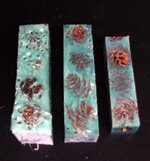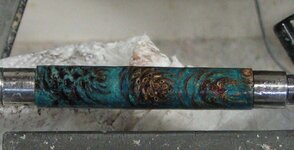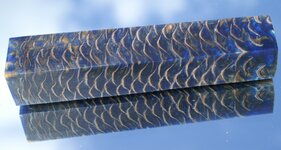I tried casting my mini pine cones finally.
They were dried for 24 hours in a 200 degree oven before Christmas. The other day I put them in the oven again at 200 for probably 8 hours just to make sure they had not absorbed any moisture since Dec.
I followed all the directions and put them in my pressure pot at 40 for an hour.
I am not sure yet how they will look once turned but the blanks ended up with a lot of air bubbles on the top and so far when I trimmed the blank there are air bubbles further in.
Photo posted
So what went wrong?
Is my tiny compressor not enough? It took at least 10 minutes to come up to 40 and then ran for the entire hour. so for most of the hour it stayed at 40. I have had problems with my pressure pot since I bought it at harbor freight. I know there is a leak but I can't find it.
Should I have held each pine cone and poured the aluminite in between the spaces before putting it in the mold?
Should the mold and aluminite be warm?
OR is this what it is supposed to look like. You cant see some of the air bubbles in the photo
I am waiting for the tube to dry in the blank.
who knows maybe it will be fine?
Alice
They were dried for 24 hours in a 200 degree oven before Christmas. The other day I put them in the oven again at 200 for probably 8 hours just to make sure they had not absorbed any moisture since Dec.
I followed all the directions and put them in my pressure pot at 40 for an hour.
I am not sure yet how they will look once turned but the blanks ended up with a lot of air bubbles on the top and so far when I trimmed the blank there are air bubbles further in.
Photo posted
So what went wrong?
Is my tiny compressor not enough? It took at least 10 minutes to come up to 40 and then ran for the entire hour. so for most of the hour it stayed at 40. I have had problems with my pressure pot since I bought it at harbor freight. I know there is a leak but I can't find it.
Should I have held each pine cone and poured the aluminite in between the spaces before putting it in the mold?
Should the mold and aluminite be warm?
OR is this what it is supposed to look like. You cant see some of the air bubbles in the photo
I am waiting for the tube to dry in the blank.
who knows maybe it will be fine?
Alice
Attachments
Last edited:




